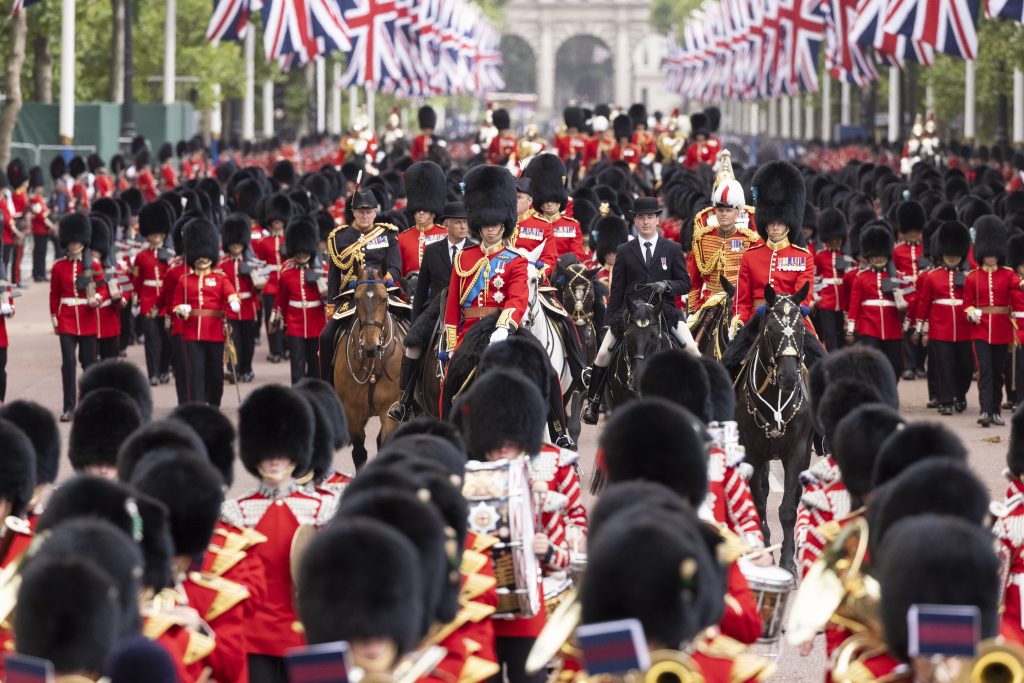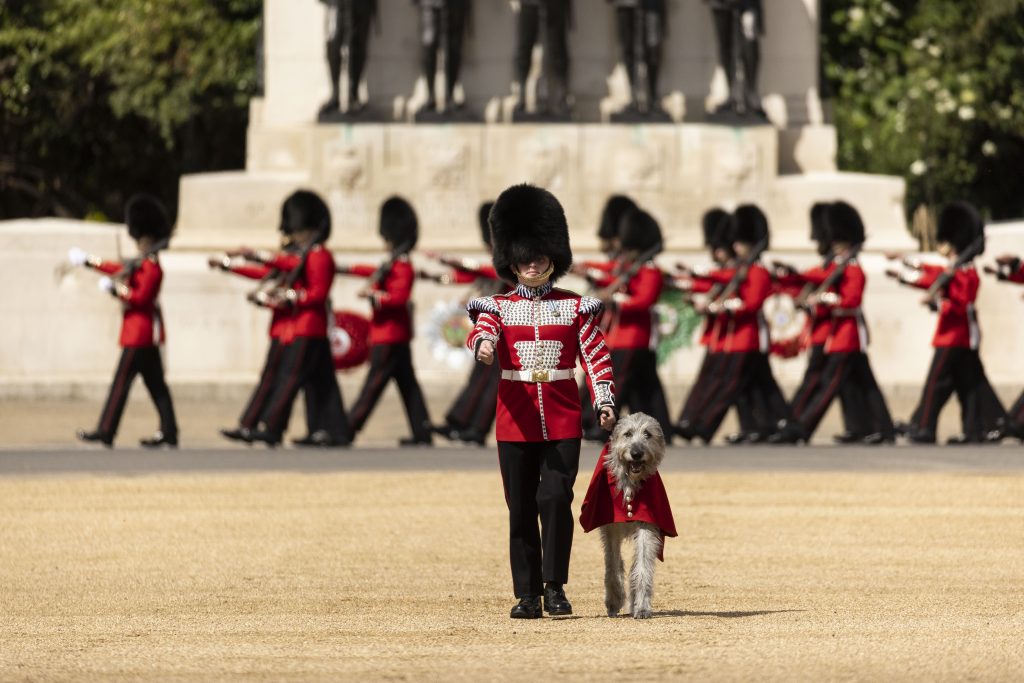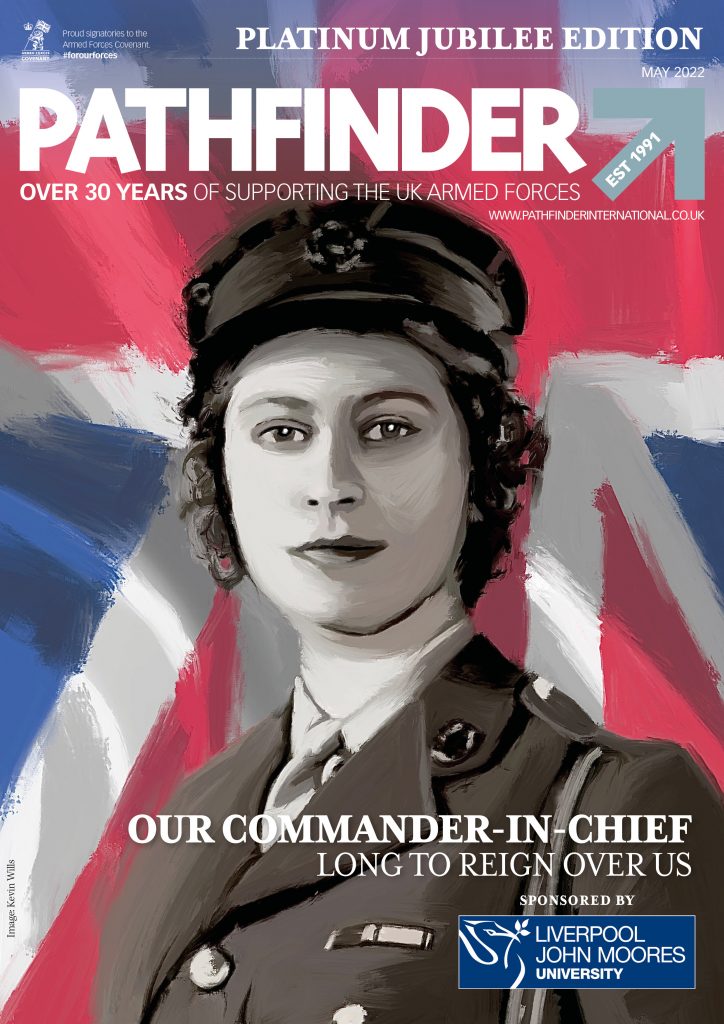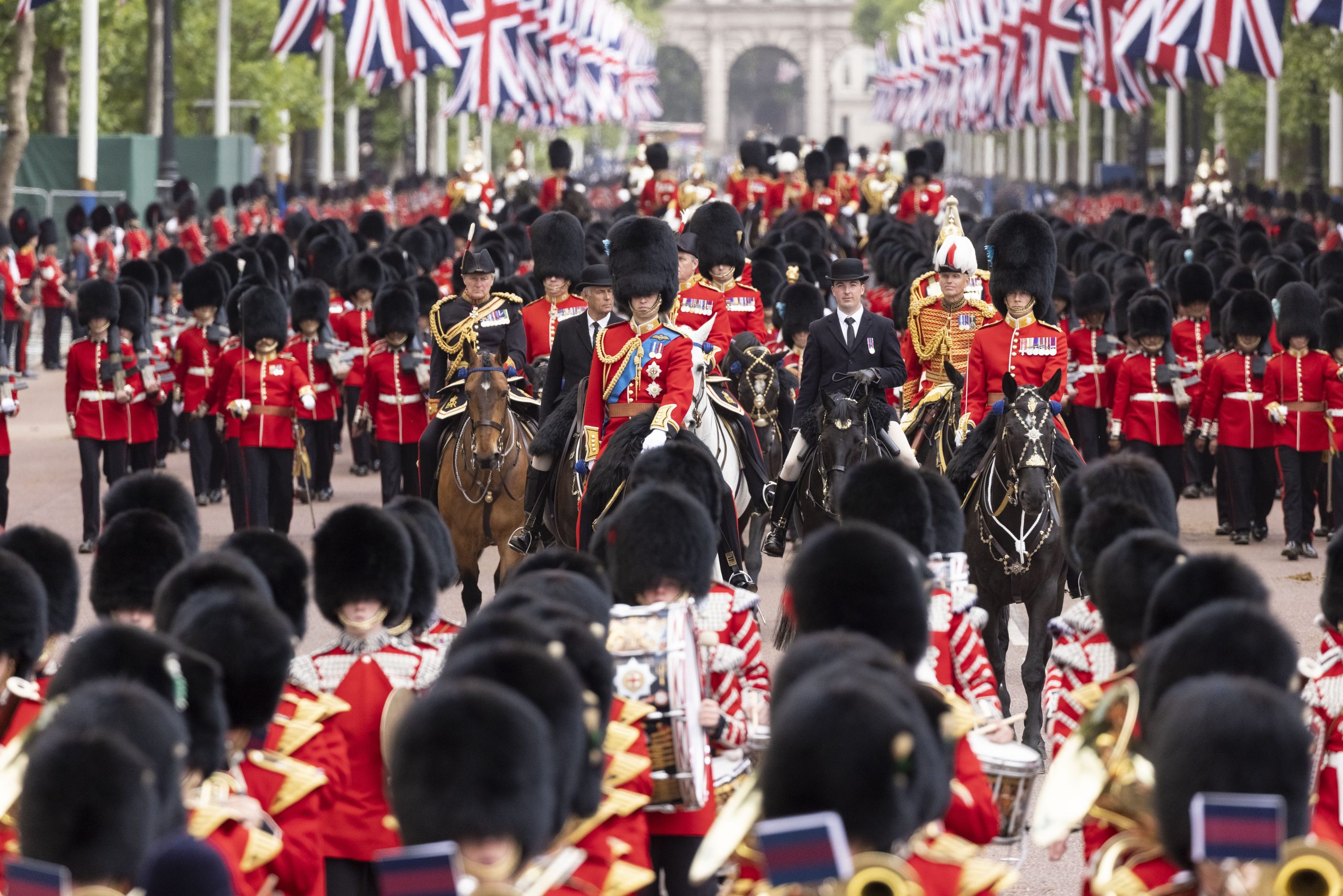More than 1,500 soldiers and 350 horses from the Household Division paraded in front of 7,000 ticketed spectators on Horse Guards Parade in London on Saturday 28th May. The Colonel’s Review is the opportunity for the Royal Colonel of the Irish Guards, HRH The Duke of Cambridge, to review his troops and ensure that they are of the required standard before The Queen’s Platinum Jubilee Birthday Parade on 2nd June. Swords, medals, buttons and breast plates will shine while horses and soldiers carry out complex battlefield drill manoeuvres to a spectacular programme of music.

This year the honour to Troop their Colour falls to the Irish Guards and every detail is designed to delight and impress. The 1st Battalion Irish Guards received their New Colours from His Royal Highness The Duke of Cambridge in a sacred ceremony on the Quadrangle at Windsor Castle on 17th May. It is these New Colours that will be centre stage for the Platinum Jubilee Trooping of the Colour Parade.Lieutenant Charles Bashall 24, will carry the Colour on parade and said: “It is an incredible privilege to be part of the Trooping the Colour Parade for the Platinum Jubilee. I am extremely fortunate to be involved in the Platinum Jubilee especially as there may never be one again.”
READ THE PLATINUM JUBILEE EDITION OF PATHFINDER INTERNATIONAL MAGAZINE HERE!
The music includes “Slattery’s Mounted Fut”, a favourite tune of Her Majesty The Queen Mother, “Long Live Elizabeth” in tribute to Her Majesty The Queen, Irish Folk songs, and “Bob’s Own” a new composition just for this event named for the first Colonel of the Irish Guards, Field Marshal Lord Roberts; as well as the reassuringly familiar traditional regimental marches.
The Irish Guards are the only Guards Regiment permitted to have their mascot lead them on parade. During Trooping of the Colour, the mascot accompanied by Drummer Adam Walsh, leads the Band of the Irish Guards, the Drums and Pipes and the Irish Guards from Wellington Barracks down The Mall and onto Horse Guards Parade.

Many of the movements and drills formed the bedrock of infantry tactics in days gone by and much of the clothing likewise draws its relevance from the frontline battlefields of previous centuries. This custom of honouring the Sovereign’s Birthday was introduced in 1805, though, due to the illness of King George III, it was suspended from 1811-1820. The ceremony was restored on the accession of King George IV and has, thankfully, thrived until the COVID-19 Pandemic, when smaller parades were held privately in Windsor for The Queen’s birthday. This will be the first full Trooping of the Colour on Horse Guards for three years.
The three-year gap has brought big challenges for the Household Division with only around 10 – 15% of participants (including Officers, Guardsmen, Gunners, Musicians and Horses!) having any experience of this complex and exacting parade. For the past three years the Irish Guards has been the most heavily committed of British Army Infantry Units on Operations. Tasked across the globe in support of the UN and NATO operations in Europe and the Middle East, at the forefront of Counter Poaching in Africa, and the lead regiment in the COVID Support Force supporting the government’s efforts to counter the pandemic across the whole of the UK, The Irish Guards have only just returned to ceremonial duties so producing a world class event worthy of the occasion and Her Majesty is a major feat but one all are proud and well prepared to deliver.
Garrison Sergeant Major WO2 Andrew Stokes whose job it is to ensure the parade and the wider support to the Platinum Jubilee four day weekend meet the exacting standards of the Household Division explained: “Her Majesty’s Platinum Jubilee events will be extraordinary. Rehearsals for the Queen’s Birthday Parade are maturing well, what is delightful to see is the passion which each Officer and Guardsman shows during our formal rehearsals on Horse Guards Parade Ground. They are enthused and want to deliver a world class Parade, and they are well on the path to doing so. The significance of the Queen’s Birthday Parade being at the front end of the Jubilee weekend is not lost on anyone. It’s going to be a tale for Grand children in years to come”.
The Queen’s Birthday Parade is the Household Division’s special opportunity to wish Her Majesty a happy birthday and illustrates all that is important about soldiering: discipline, detail, teamwork, commitment and endurance. Popularly known as Trooping the Colour, it is when the Queen’s Colour (Regimental flag) is “Trooped” in front of Her Majesty The Queen and all of the Royal Colonels.
READ THE PLATINUM JUBILEE EDITION OF PATHFINDER INTERNATIONAL MAGAZINE HERE!
The Duke of Cambridge was appointed as the Irish Guards’ first Royal Colonel by Her Majesty The Queen in 2011. He has a strong commitment to the Regiment and the wider regimental family of whom he is head. He visits the Irish Guards regularly whether for annual celebrations such as their St Patrick’s Day Parades or during their overseas operational commitments.
The Irish Guards was formed by order of HM Queen Victoria on 1st April 1900 to commemorate the bravery of Irish Regiments in South Africa. Irish soldiers had featured prominently in that campaign and many others before. From the very outset of the regiment’s formation the pedigree of the Irish soldier was considered to be of a high quality; in particular soldiers from County Tipperary, despite one of the lowest population densities in the British Isles, accounted for the highest number of Victoria Cross winners. The first officers and soldiers of the Irish Guards came from other Regiments of Foot Guards serving at the time of formation. Forming part of the Guards Mounted Infantry Company these first Irish Guards officers and soldiers saw immediate service in South Africa against the Boers.
The distinctive Irish Guards blue plume is said to have been the result of a quick thinking wife of one of the first officers associated with the Regiment. Green plumes were already worn by the Royal Dublin Fusiliers, and therefore unsuitable, so Lady Settrington the wife of the Aide-de-Camp to Field Marshal Lord Roberts VC (the first Colonel of the Irish Guards) dipped her husband’s white Grenadier plume into an ink well to produce a blue plume for the new Irish Regiment. The blue coloured plume was the same as the sash and mantle of the Order of St Patrick; affectionately known as St Patrick’s Blue from then on. The original plume is still held in the Guards Museum in Wellington Barracks.
The Irish Guards have served with distinction at every opportunity through the two World Wars and in the period since then in Hong Kong, Belize, Aden, Germany, Northern Ireland, Kosovo, Iraq and Afghanistan. Eight Victoria Crosses and a total of 52 Battle and Theatre Honours have been awarded to members of the Regiment since its inception.
‘The Micks’, as they are affectionately known, will move to 11 Security Force Assistance Brigade in August 22 while also creating for the first time two public duties companies to continue to perform ceremonial commitments. In the Security Force Assistance role, soldiers of the Irish Guards will deploy to Africa to assist in the training and development of partner nation security forces.
A diverse regiment, the Irish Guards draws soldiers from all over the British Isles and the Republic
of Ireland, as well as the wider Commonwealth. Trained at Catterick and honed in battalion, the Micks are a tight-knit family. Once a Mick, always a Mick, as embodied in the motto, Quis Separabit: ‘who shall separate us’.
The background of the Parade
The parade, also known as Trooping the Colour, has origins tracing back to the Middle Ages, each Lord or Baron flew his banner as a sign by which his followers could distinguish him in battle. As more flags were created they assumed a diversity of hues and came to be called ‘Colours’. The principal role of a regiment’s Colours was to provide a rallying point on the battlefield. This was essential because, without modern communications, it was all too easy for troops to become disoriented and separated from their unit during conflict. But if troops were to be able to find their Colours in the chaos of the battlefield they needed to be able to recognise them and therefore it became the practice to display them regularly. This was achieved by parading the troops and having an officer march along the ranks with the Colours held high. Colours were last carried into action by the 58th Foot in South Africa in 1881, but ‘trooping’ ceremonies continue to this day.
READ THE PLATINUM JUBILEE EDITION OF PATHFINDER INTERNATIONAL MAGAZINE HERE!


